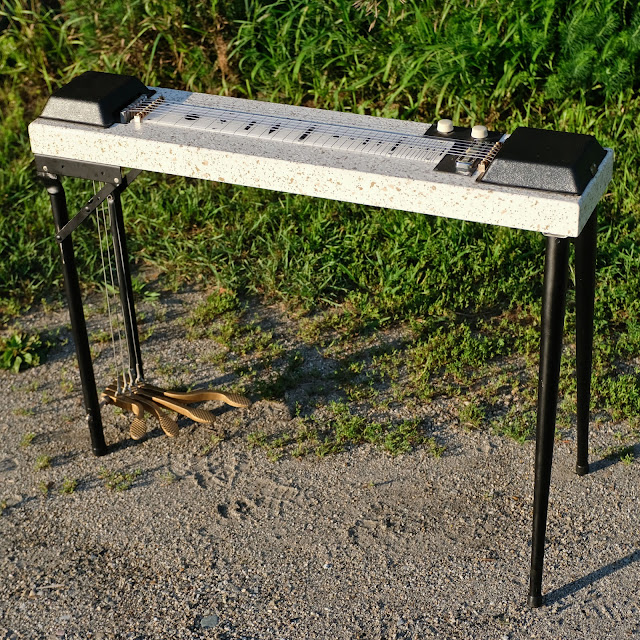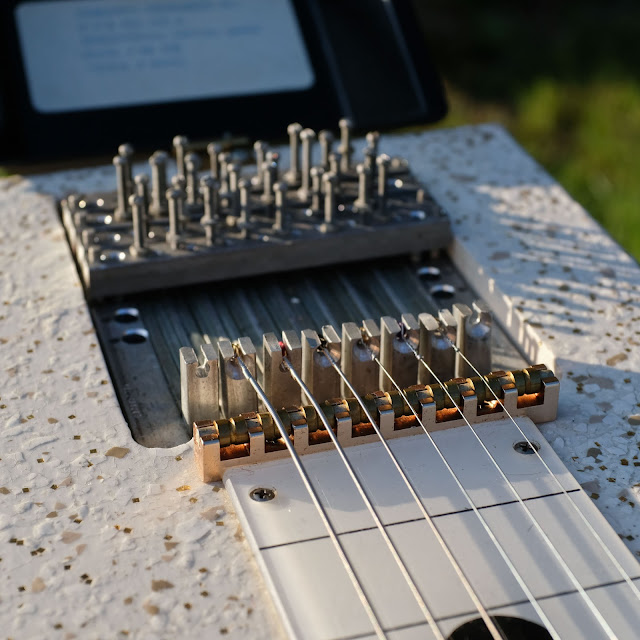1960s Harlin Multi-Kord 8-String Pedal Steel Guitar
Happy day! I finally got around to getting a pedal steel for myself. This old 4-pedal Harlin Multi-Kord is definitely not a Sho-Bud or Emmons, but it does get the job done for a slide-dunce like myself. The tuning-changer mechanism on these is dang-good but the design has a few weak points -- it's not as physically stable (as in -- it wobbles some in the legs when you play, though it's tuning-stable) as "proper" steels and the cables that attach the pedals to the changer blocks have a bit of slack compared to "proper" rods. Still, going through all of that mechanical stuff and sorting it out has yielded a perfectly useful instrument.
It's an 8-string but I have it knocked down to 6 and tuned to open D (DADF#AD) which is a tuning my brain is wrapped-around on "normal" guitar quite well. I wanted a 6-string version but this was at the right price. I lucked-out on that in some ways, though, because the big wooden body of this one is regarded as a little more stable than the more-composite earlier versions.
I knew I wasn't going to wrap my head around a "real" pedal steel tuning, so the open D configuration makes it easy for me to figure some of this out. I have the pedals set so #1 changes the chord to a 5 (from D maj to A maj, say), #2 raises the third a half-step (F# to a G), #3 raises the fifths a step to a 6th chord (A to B -- which I incorrectly call a 7th in the video clip, sorry), and #4 lowers the third a half-step (F# to F) to get a minor chord. By pressing #2 and #3 together, I get the 4-chord.
In this layout, I can leave my bar in one position and play the "country" chords out of that one position save the relative minor. I am thinking I want to switch the 5-chord pedal to do individual strings, though, as it's easy-enough just to punch-in the 4-chord and move up two frets to get the 5.
So, to put it plainly -- this is a lot of fun. I was way too intimidated to play a "real" steel tuning, so this is a nice alternative to me and I'm beginning to get the hang of things a bit.
Specs are: 23" scale, 2 1/8" string spacing nut and saddle (for 6 string) or 2 7/8" spacing (for 8 string), and 36" overall length, 8" width, and 2" depth with 27" height legs-installed.
The instrument is 100% original and while I don't have a picture of it, it does have an awesome medium-blue hard case with red interior.
The covering is a reflective-gold-flake bit of silliness with black and grey speckles thrown-in. My least-favorite design element are the covers for the tuners and changer unit... which look like something yanked out of an auto-parts store and cut to fit.
The nut and saddle are roller units, of course.
The changer unit is pretty ingenious and allows for changing of the entire chord if desired. Each string is adjustable up-and-down in pitch. Once you dial in your setting via the set-screws, you lock them tight with the nuts. Changing your setup on the fly is thus really fast.
The tuners seem to be Kluson units are are nothing really special, though they do hold pitch just fine.
The pickup is a thin, decent-output DeArmond unit. It has a great clean sound and a kerrang-y driven sound.
The pedal design hadn't changed since the early '50s.











Comments
I have a 6 string, 4 pedal Multi-Kord. Am trying to tune it but running into a problem. I think the tuning knobs might be slipping. That would mean removing the entire tuning apparatus and either tightening the screws or replacing the tuners. Also, I find it hard to lock in the little nuts when I'm trying to tune it, as I don't have the original tuning tool (a screwdriver/wrench contraption) that Harlin Brothers supplied with the original instruments. Do you have any suggestions for me?
Thanks,
Allen
202-288-4048
My email is charlir8@yahoo.com